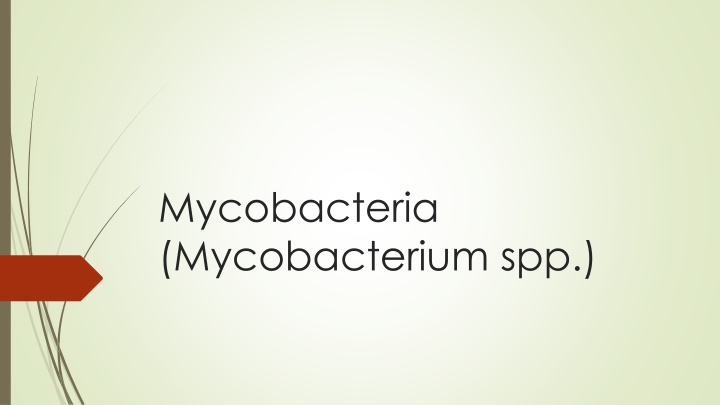
Characteristics and Laboratory Diagnosis of Mycobacteria
Learn about Mycobacteria (Mycobacterium spp.), rod-shaped acid-fast bacteria that are resistant to antibiotics and dyes. Understand the properties, lab diagnosis techniques, specimen collection, and culture media used for detecting Mycobacteria infections.
Uploaded on | 0 Views
Download Presentation

Please find below an Image/Link to download the presentation.
The content on the website is provided AS IS for your information and personal use only. It may not be sold, licensed, or shared on other websites without obtaining consent from the author. If you encounter any issues during the download, it is possible that the publisher has removed the file from their server.
You are allowed to download the files provided on this website for personal or commercial use, subject to the condition that they are used lawfully. All files are the property of their respective owners.
The content on the website is provided AS IS for your information and personal use only. It may not be sold, licensed, or shared on other websites without obtaining consent from the author.
E N D
Presentation Transcript
Mycobacteria (Mycobacterium spp.)
Rod aerobic bacteria that do not form spore and do not stain readily; they resist decolarization by acid or alcohol and are therefore called 'acid-fast' bacilli
Important properties 1) Slender, straight-slightly curved rod arranged in single or pair (small bindles or small parallel bacilli and not G-ve or G-ve, they are stained poorly by dyes in Grams stain. The special stain for Mycobacterium(A.F.B.) is Zehil Neelson stain, non- motile, non-capsulated 2) They are resistant to many antibiotics, strong acid, alkaline and dyes like malachite green. The optimal temp.37 c and the thermal death point of Mycobacterium tuberculosis 60 c for 15-20 min.
Lab. Diagnosis: 1. Specimen: a) Fresh sputum which is mixed pus and mucous membrane secretion coughed up from the lung. b) Gastric washing when little sputum may be produced but immediately swallowed in this case, early morning fasting gastric juices must be collected. c) Others: Urine, pleural fluid, CSF Joints fluid biopsy blood and other suspected material 1) The optimal temp.37 c and the thermal death point of Mycobacterium tuberculosis 60 c for 15-20 min.
Specimens from sputum and other non- sterile sites should be: A.Liquefied with N-acetyl-L- cystine. B.Decontamination with NaOH 4% kill a many bacteria and fungi. C.Neutralized with buffer. D.Concentrated by centrifugation, take the sediment. All the specimens processed in this way can be used for Zehil -Neelson stain and for culture except the specimens from sterile site such as CSF do not need the decontamination. 3.Smear: sputum, exudates or other material is examine for acid fast bacilli (A.F.B.) by Zehil-Neelson stain.
4- Culture (Media) Lowenstein -Jensen medium contains 1. Egg Yolk, glycerol as complex. 2. Dyes like malachite green for inhibit the unwanted normal flora present in sputum sample. Incubation condition: Incubation is at 37 c with 5-10%CO; for up 8 weeks because Mycobacterium slow grower bacteria). It considered as negative result if there is no growth. If there are colonies lock like tooth it considers as positive tuberculosis.






















